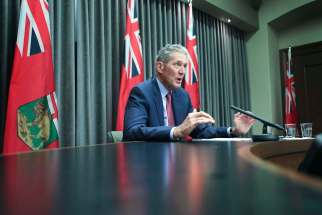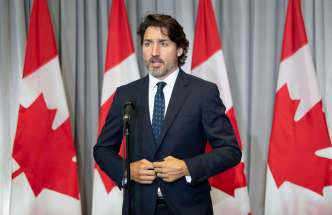Case of the premier who wasn’t always there
Read this article for free:
or
Already have an account? Log in here »
To continue reading, please subscribe:
Monthly Digital Subscription
$0 for the first 4 weeks*
- Enjoy unlimited reading on winnipegfreepress.com
- Read the E-Edition, our digital replica newspaper
- Access News Break, our award-winning app
- Play interactive puzzles
*No charge for 4 weeks then price increases to the regular rate of $19.00 plus GST every four weeks. Offer available to new and qualified returning subscribers only. Cancel any time.
Monthly Digital Subscription
$4.75/week*
- Enjoy unlimited reading on winnipegfreepress.com
- Read the E-Edition, our digital replica newspaper
- Access News Break, our award-winning app
- Play interactive puzzles
*Billed as $19 plus GST every four weeks. Cancel any time.
To continue reading, please subscribe:
Add Free Press access to your Brandon Sun subscription for only an additional
$1 for the first 4 weeks*
*Your next subscription payment will increase by $1.00 and you will be charged $16.99 plus GST for four weeks. After four weeks, your payment will increase to $23.99 plus GST every four weeks.
Read unlimited articles for free today:
or
Already have an account? Log in here »
Hey there, time traveller!
This article was published 24/09/2020 (1904 days ago), so information in it may no longer be current.
With COVID-19 cases surging in Winnipeg and lineups for testing facilities stretching for blocks, Premier Brian Pallister spent an astounding eight days away from Manitoba, in the nation’s capital.
What, you may ask, did Manitobans get for the prolonged absence?
Based on the details shared at a Thursday news conference, the trip allowed Pallister to meet with three other premiers to press Ottawa for more health funding, and undertake a series of “relationship-building” meetings with bureaucrats, lobby groups and federal cabinet ministers.
He also acquired a daring new communications strategy designed to hide Manitoba’s sorry record on wait times for priority medical procedures. (More on that later.)
Does all that justify the decision to fly Sept. 15 to Ontario, at a time when public health officials have asked Manitobans to only travel for urgent and pressing reasons?
Pallister provided no specifics but as soon as he began to describe what he did in Ottawa, and for how long, it became clear the trip was neither urgent, nor pressing.
He claimed he worked six of eight days and had meetings on five of those days. Further, even though all of the people he wanted to meet were in Ottawa, several scheduled meetings — including a brief chat with Prime Minister Justin Trudeau — were conducted via video conference.

Most of Canada’s premiers didn’t see a need to be in Ottawa for the health funding summit. As for the four who did, both Quebec Premier François Legault and Alberta Premier Jason Kenney realized when it comes to travel these days, less is more; they spent only a single day in Ottawa before returning home.
It also deserves to be mentioned most of the groups Pallister said he met with — Canadian Chamber of Commerce, Conference Board of Canada, and Institute of Fiscal Studies and Democracy — were the same groups he met with in early July, during another seemingly contrived trip to Ottawa.
This latest sojourn is part of a pattern former Tory staffers described as “find me a reason to travel.” At regular points during his term as premier, former political aides said Pallister directs staff to arrange meetings in a particular location to justify a trip, with non-working days tacked on to the end of official duties.
As part of this exercise, details of his itinerary are withheld from journalists until after he returns.
That was the case in 2018, when the premier and his wife went on a week-long, 1,200-kilometre road trip to Iowa, to talk with researchers about driving and cannabis use.
In June 2019, there was the infamous visit to France for the 75th anniversary of D-Day, where he snubbed Manitoba veterans by skipping the main memorial service to visit a French company building a pea-processing plant in the province. That trip also included at least as many non-working days as working days.
To be fair, Pallister is correct to raise concerns about how a reduction in the federal share of total health-care spending. He is also correct there is an argument for increased federal support for health care.
Pallister is always careful to note he does not charge taxpayers for personal expenses on non-working days.
That does not, however, justify the decision to manufacture a purpose for a trip — particularly at a time when travel exponentially increases chances of contracting COVID-19.
The tenuous defence of his latest trip Thursday was almost enough to get reporters to ignore the premier’s astounding new theory about why wait times for priority medical procedures in Manitoba have continued to grow: it’s Ottawa’s fault.
To be fair, Pallister is correct to raise concerns about how a reduction in the federal share of total health-care spending. He is also correct there is an argument for increased federal support for health care.
Pallister said the federal government should be providing at least 25 per cent of all provincial and territorial health care spending. In reality, he said, Ottawa barely covers only 20 per cent.
That is a damning indictment, but it comes with footnotes.
… in pure mathematical terms, the federal government is covering a greater share of health-care spending in Manitoba now than it was in 2016.
First, the provinces are talking about all of their spending on health care, not services officially covered by the Canada Health Transfer. According to the Parliamentary Budget Office, Ottawa covers more than one-third of the cost of those services. (Other items, such as home care, are not within the scope of the CHT but are often funded with one-time money from Ottawa.)
Pallister’s argument also neglects to mention, under his watch, year-end annual increases in health funding have failed to keep up with inflation and population growth. Not surprisingly, wait times for priority procedures (cataract, hip and knee operations, MRIs/CTs) have gone up.
During the same period of time, federal health transfer payments increased by three per cent annually, and equalization payments have gone up by more than $100 million in three of the four years Pallister has led the Manitoba government. So, in pure mathematical terms, the federal government is covering a greater share of health-care spending in Manitoba now than it was in 2016.
Pallister also neglects to mention instead of providing more money to health care, he spent more than $1 billion on tax cuts and a huge deposit to the province’s fiscal stabilization fund.
If priority medical procedures is the foundation of government services, as he argued Thursday, he ought to put his money where his mouth is.
If the premier is going to run the COVID-19 gauntlet to visit Ottawa to recharge his batteries and build relationships, you would think he could come back with a stronger argument about the future of health-care funding.
Oh well, maybe next trip eastward.
dan.lett@freepress.mb.ca

Born and raised in and around Toronto, Dan Lett came to Winnipeg in 1986, less than a year out of journalism school with a lifelong dream to be a newspaper reporter.
Our newsroom depends on a growing audience of readers to power our journalism. If you are not a paid reader, please consider becoming a subscriber.
Our newsroom depends on its audience of readers to power our journalism. Thank you for your support.
History
Updated on Thursday, September 24, 2020 8:26 PM CDT: Corrects info that Pallister was in Ottawa for eight days, not nine






